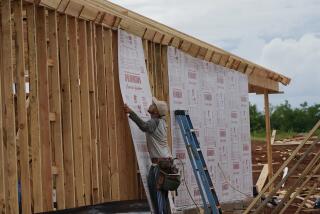The Building You’re In Fuels Global Warming
- Share via
In our quest to dramatically cut greenhouse gas emissions and lessen our dependence on fossil fuels, we have contented ourselves by pointing a finger at gas-guzzling SUVs. And in doing so we have overlooked the biggest source of emissions and energy consumption both in this country and around the globe: architecture.
If you took all sport utility vehicles off the road tomorrow and replaced them with hybrids, the effect on energy use and global warming would be minimal. The entire fleet of SUVs, minivans and light-duty trucks in this country accounts for only 6.5% of the total U.S. energy consumed each year, according to the U.S. Energy Information Administration. And although that doesn’t mean we should abandon efforts to produce more efficient, environmentally friendly SUVs, it does illustrate a huge blind spot in U.S. energy consciousness.
Buildings and their construction account for nearly half of all the greenhouse gas emissions and energy consumed in this country each year. Globally, the percentage is even greater. And architects hold the key to turning down the global thermostat.
The reason for this is quite simple. Though our country’s fleet of autos and light trucks could turn over within about 12 years and be replaced by more efficiently run vehicles, buildings have a lifespan (and energy consumption and emissions pattern) of 50 to 100 years.
The problem is that buildings consume energy mainly in the form of burning oil, natural gas and coal, and U.S. oil and gas production has been in decline since the 1970s. Global oil and natural gas reserves are limited; most of these remaining reserves are in a small area stretching from Saudi Arabia to Siberia, an unstable part of the world. This leaves coal. The U.S., Russia, China, Australia and India have plenty of it, and it is cheap -- and dirty. Clean coal technologies are decades away -- as is capturing and storing carbon dioxide -- and they are costly.
Architects know that buildings can be designed to require less than half the energy of today’s average U.S. building, with no additional cost. This is accomplished through proper siting, building form, material selection and glass properties and location and by incorporating day-lighting strategies and natural heating, cooling and ventilation.
To achieve such a reduction, government at all levels must pass laws that all major governmental building renovation and new building projects be designed to use half the energy now typically consumed. When these standards are in widespread use, building codes for all housing developments and commercial, institutional and multifamily buildings can be changed to the standard in place for government buildings.
With about 5 billion square feet of new construction and 5 billion square feet of renovation taking place in the U.S. each year, the potential for reducing energy consumption and carbon dioxide emissions is enormous. This would put the U.S. well on its way toward meeting its international obligations and demonstrate a way for developing nations to cut emissions without sacrificing economic growth.
There is no short-term or long-term greenhouse gas solution possible without involving the architectural and building communities. With abrupt rather than gradual climate change looming as a possibility, quickly engaging this sector becomes critical.
Edward Mazria is an architect in Santa Fe, N.M. He is author of “The Passive Solar Energy Book” (Rodale Press, 1979).

